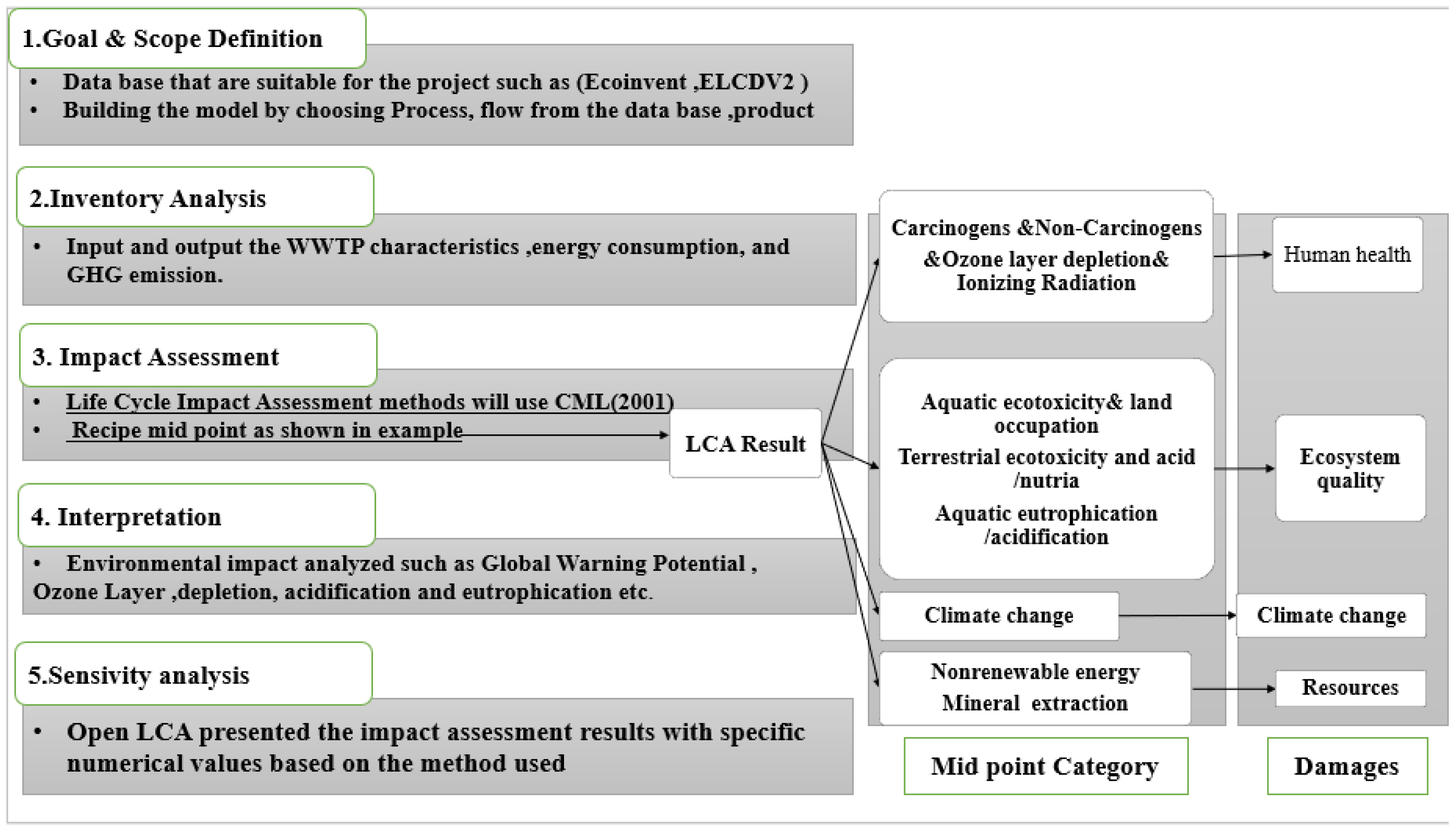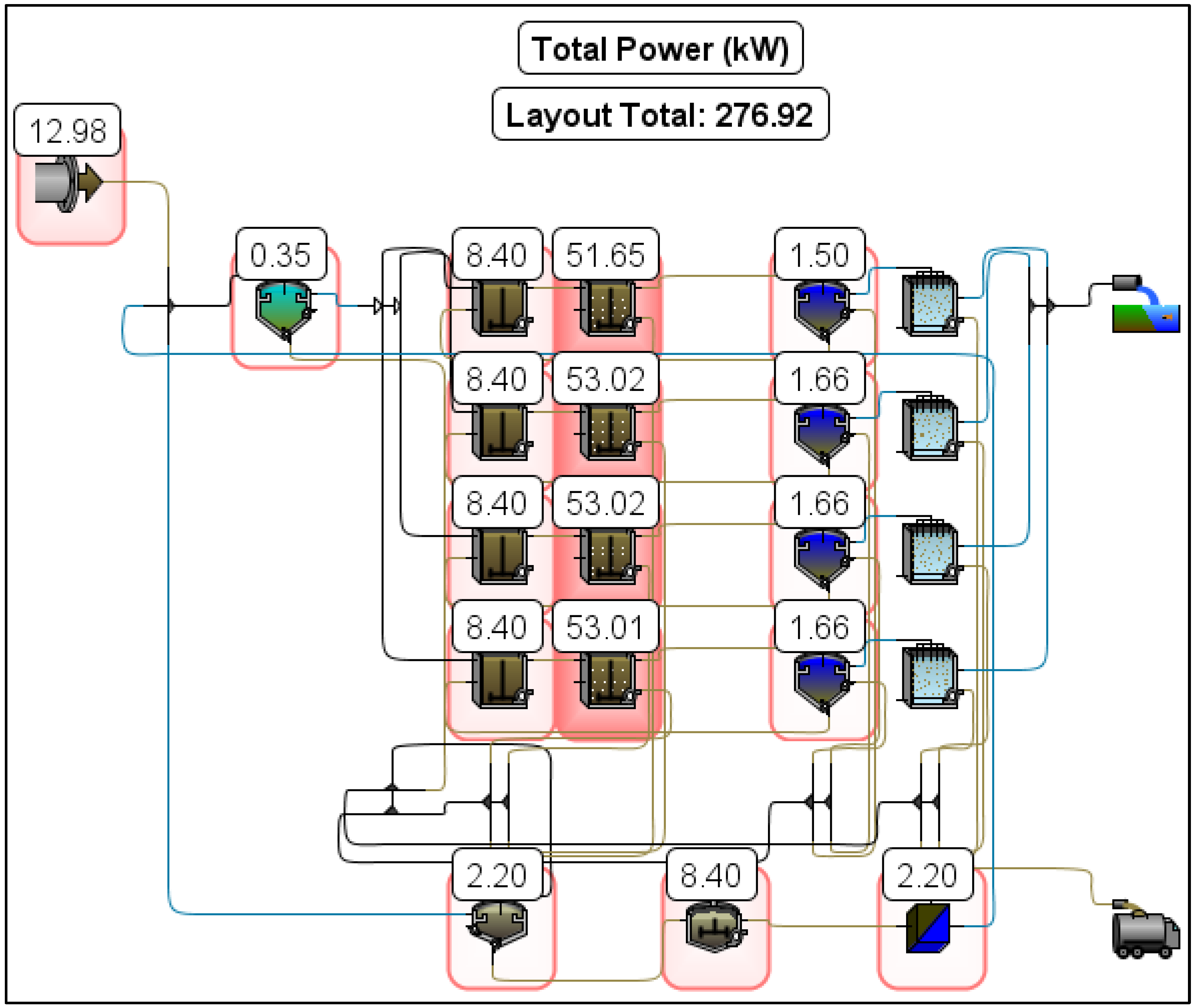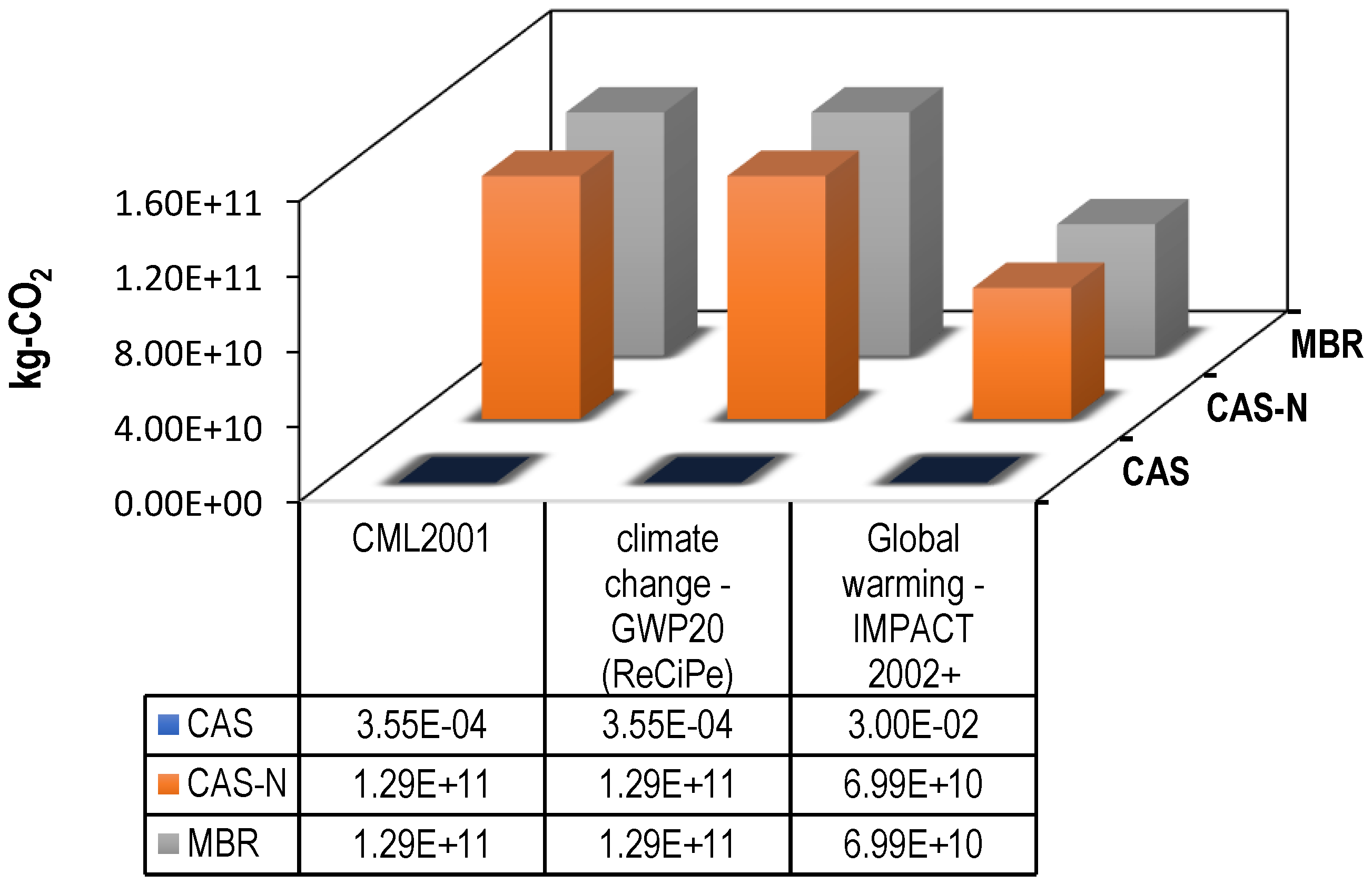Life Cycle Assessment of a Domestic Wastewater Treatment Plant Simulated with Alternative Operational Designs
Abstract
1. Introduction
2. Materials and Methods
2.1. The Case-Study WWTP
2.2. Examined Operational Alternatives
2.3. Estimation of GHG Emissions and Energy Consumption
2.4. LCA Considerations and Software
3. Results and Discussion
3.1. First Alternative: Conventional Activated Sludge with Sand Filter (CAS)
3.1.1. Result of the Preliminary Design of Russtmiya WWTP
3.1.2. Estimation of GHG Emissions
3.1.3. Energy Consumption
3.1.4. LCA for the Alternative
3.2. Second Alternative: Conventional Activated Sludge with Sand Filter and Nitrogen Removal (CAS-N)
3.2.1. Results of the Preliminary Design of Russtmiya WWTP
3.2.2. Estimation of GHG Emissions
3.2.3. Energy Consumption
3.2.4. LCA for the Alternative
3.3. Third Alternative: Membrane Bioreactor (MBR)
3.3.1. Result of the Preliminary Design of Russtmiya WWTP
3.3.2. Estimation of GHG Emissions
3.3.3. Energy Consumption
3.3.4. LCA for the Alternative
3.4. Comparison between the Three Alternatives
3.4.1. Estimation of GHG Emissions
3.4.2. Energy Consumption
3.4.3. LCA
4. Conclusions
Supplementary Materials
Author Contributions
Funding
Conflicts of Interest
Abbreviations
| GHG | Greenhouse Gases |
| WWTP | Wastewater Treatment Plant |
| LCA | Life Cycle Assessment Impact |
| CAS | Conventional Activated Sludge |
| CAS-N | Conventional Activated Sludge with Nitrogen Removal |
| MBR | Membrane Bioreactor |
| BOD | Biochemical Oxygen Demand |
| CH4 | Methane |
| CO2 | Carbon Dioxide |
| CO2eq | Carbon Dioxide Equivalent |
| COD | Chemical Oxygen Demand |
| GPS-X | General Purpose Simulator |
| OD | Oxidation Ditch |
| SBR | Sequencing Batch Reactor |
| AAO | Anaerobic–Anoxic-Oxic |
| AO | Anaerobic-Oxic |
| IFAS | Integrated Fixed Activated Sludge |
| IPCC | The Intergovernmental Panel on Climate Changes |
| USEPA | The United States Environmental Protection Agency |
| N2O | Nitrous Oxide |
References
- Ministry of Planning/Central Organization for Statistics and Information Technology (COSIT); Ministry of Municipalities and Public Works; Ministry of Environment; Baghdad Municipality; Ministry of Planning/Statistics Office of the Kurdistan Region; Ministry of Municipalities of the Kurdistan Region; Ministry of Environment of the Kurdistan Region; In cooperation with UNICEF. Environmental Survey in Iraq 2010: Water-Sanitation-Municipal Services. Available online: https://reliefweb.int/report/iraq/environmental-survey-iraq-2010-water-sanitation-municipal-services-detailed-report (accessed on 12 August 2021).
- Wanjiru, E.; Xia, X.; Xia, X. Optimal Energy-Water Management in Urban Residential Buildings through Grey Water Recycling. Sustain. Cities Soc. 2017, 32, 654–668. [Google Scholar] [CrossRef]
- Gallego-Schmid, A.; Tarpani, R.R.Z. Life Cycle Assessment of Wastewater Treatment in Developing Countries: A Review. Water Res. 2019, 153, 63–79. [Google Scholar] [CrossRef] [PubMed]
- Mathematics, A. Rice Straw Utilisation for Bioenergy Production. Energies 2016, 15, 5542. [Google Scholar]
- Rashid, S.S.; Harun, S.N.; Hanafiah, M.M.; Razman, K.K.; Liu, Y.Q.; Tholibon, D.A. Life Cycle Assessment and Its Application in Wastewater Treatment: A Brief Overview. Processes 2023, 11, 208. [Google Scholar] [CrossRef]
- Iswara, A.P.; Farahdiba, A.U.; Nadhifatin, E.N.; Pirade, F.; Andhikaputra, G.; Muflihah, I.; Boedisantoso, R. A Comparative Study of Life Cycle Impact Assessment Using Different Software Programs. In Proceedings of the IOP Conference Series: Earth and Environmental Science; IOP Publishing: Bristol, UK, 2020; Volume 506, p. 012002. [Google Scholar]
- OpenLCA Nexus: The Source for LCA Data Sets. Available online: https://nexus.openlca.org/database/ecoinvent (accessed on 26 September 2022).
- OpenLCA. OpenLCA Is a Free, Professional Life Cycle Assessment (LCA) and Footprint Software with a Broad Range of Features and Many Available Databases, Created by GreenDelta since 2006. Available online: https://www.openlca.org/ (accessed on 26 September 2022).
- Delre, A.; ten Hoeve, M.; Scheutz, C. Site-Specific Carbon Footprints of Scandinavian Wastewater Treatment Plants, Using the Life Cycle Assessment Approach. J. Clean. Prod. 2019, 211, 1001–1014. [Google Scholar] [CrossRef]
- Aleisa, E.; Al-Mutiri, A. Life Cycle Assessment for Tertiary Wastewater Treatment and Reuse versus Seawater Desalination. IOP Conf. Ser. Earth Environ. Sci. 2022, 1026, 012001. [Google Scholar] [CrossRef]
- Corominas, L.; Flores-Alsina, X.; Snip, L.; Vanrolleghem, P.A. Comparison of Different Modeling Approaches to Better Evaluate Greenhouse Gas Emissions from Whole Wastewater Treatment Plants. Biotechnol. Bioeng. 2012, 109, 2854–2863. [Google Scholar] [CrossRef]
- Ahmed, M.T. Life Cycle Analysis in Wastewater: A Sustainability Perspective. In Waste Water Treatment and Reuse in the Mediterranean Region; Springer: Berlin/Heidelberg, Germany, 2010; pp. 125–154. [Google Scholar]
- Larrey-Lassalle, P.; Catel, L.; Roux, P.; Rosenbaum, R.K.; Lopez-Ferber, M.; Junqua, G.; Loiseau, E. An Innovative Implementation of LCA within the EIA Procedure: Lessons Learned from Two Wastewater Treatment Plant Case Studies. Environ. Impact Assess. Rev. 2017, 63, 95–106. [Google Scholar] [CrossRef]
- Kyung, D.; Kim, M.; Chang, J.; Lee, W. Estimation of Greenhouse Gas Emissions from a Hybrid Wastewater Treatment Plant. J. Clean. Prod. 2015, 95, 117–123. [Google Scholar] [CrossRef]
- Yerushalmi, L.; Ashrafi, O.; Haghighat, F. Reductions in Greenhouse Gas (GHG) Generation and Energy Consumption in Wastewater Treatment Plants. Water Sci. Technol. 2013, 67, 1159–1164. [Google Scholar] [CrossRef]
- Mamais, D.; Noutsopoulos, C.; Dimopoulou, A.; Stasinakis, A.; Lekkas, T.D. Wastewater Treatment Process Impact on Energy Savings and Greenhouse Gas Emissions. Water Sci. Technol. 2015, 71, 303–308. [Google Scholar] [CrossRef] [PubMed]
- Fighir, D.; Teodosiu, C.; Fiore, S. Environmental and Energy Assessment of Municipal Wastewater Treatment Plants in Italy and Romania: A Comparative Study. Water 2019, 11, 1611. [Google Scholar]
- Arnell, M.; Rahmberg, M.; Oliveira, F.; Jeppsson, U. Multi-Objective Performance Assessment of Wastewater Treatment Plants Combining Plant-Wide Process Models and Life Cycle Assessment. J. Water Clim. Chang. 2017, 8, 715–729. [Google Scholar] [CrossRef]
- Lehtinen, H.; Saarentaus, A.; Rouhiainen, J.; Pitts, M.; Azapagic, A. A Review of LCA Methods and Tools and Their Suitability for SMEs List of Contents; Europe Innova Eco-Innovation BioChem: Manchester, UK, 2011. [Google Scholar]
- Nguyen, T.K.L.; Ngo, H.H.; Guo, W.S.; Chang, S.W.; Nguyen, D.D.; Nghiem, L.D.; Nguyen, T.V. A Critical Review on Life Cycle Assessment and Plant-Wide Models towards Emission Control Strategies for Greenhouse Gas from Wastewater Treatment Plants. J. Environ. Manag. 2020, 264, 110440. [Google Scholar] [CrossRef] [PubMed]
- Awad, H.; Alalm, M.G.; El-Etriby, H.K. Environmental and Cost Life Cycle Assessment of Different Alternatives for Improvement of Wastewater Treatment Plants in Developing Countries. Sci. Total Environ. 2019, 660, 57–68. [Google Scholar] [CrossRef] [PubMed]
- Piao, W.; Kim, Y.; Kim, H.; Kim, M.; Kim, C. Life Cycle Assessment and Economic Efficiency Analysis of Integrated Management of Wastewater Treatment Plants. J. Clean. Prod. 2016, 113, 325–337. [Google Scholar] [CrossRef]
- Gallego, A.; Hospido, A.; Moreira, M.T.; Feijoo, G. Environmental Performance of Wastewater Treatment Plants for Small Populations. Resour. Conserv. Recycl. 2008, 52, 931–940. [Google Scholar] [CrossRef]
- Préndez, M.; Lara-González, S. Application of Strategies for Sanitation Management in Wastewater Treatment Plants in Order to Control/Reduce Greenhouse Gas Emissions. J. Environ. Manag. 2008, 88, 658–664. [Google Scholar] [CrossRef]
- Siddiqi, A.; Anadon, L.D. The Water–Energy Nexus in Middle East and North Africa. Energy Policy 2011, 39, 4529–4540. [Google Scholar] [CrossRef]
- Zappone, M.; Fiore, S.; Genon, G.; Venkatesh, G.; Brattebø, H.; Meucci, L. Life Cycle Energy and GHG Emission within the Turin Metropolitan Area Urban Water Cycle. Procedia Eng. 2014, 89, 1382–1389. [Google Scholar] [CrossRef]
- Cornejo, P.K.; Zhang, Q.; Mihelcic, J.R. Quantifying Benefits of Resource Recovery from Sanitation Provision in a Developing World Setting. J. Environ. Manag. 2013, 131, 7–15. [Google Scholar] [CrossRef] [PubMed]
- Lorenzo-Toja, Y.; Vázquez-Rowe, I.; Chenel, S.; Marín-Navarro, D.; Moreira, M.T.; Feijoo, G. Eco-Efficiency Analysis of Spanish WWTPs Using the LCA+ DEA Method. Water Res. 2015, 68, 651–666. [Google Scholar] [CrossRef]
- Abeer, A.; Al-Sakini, Y. Rustumiya Sanitation Project and Its Effects on Polluting Diyala River. Adab. Al-Basrah 2016, 2016, 243–268. [Google Scholar]
- Alanbari, M.A.; Al-Ansari, N.; Altaee, S.A.; Knutsson, S. Application of Simapro7 on Karbala Wastewater Treatment Plant, Iraq. J. Earth Sci. Geotech. Eng. 2014, 4, 55–68. [Google Scholar]
- Al-Rawi, S.M. Contribution of Man–Made Activities to the Pollution of the Tigris within Mosul Area/IRAQ. Int. J. Environ. Res. Public Health 2005, 2, 245–250. [Google Scholar] [CrossRef]
- Hydromantis Inc. GPS-X Technical Reference 2018; Hydromantis Inc.: Hamilton, ON, Canada, 2018. [Google Scholar]
- Arroyo, P.; Molinos-Senante, M. Selecting Appropriate Wastewater Treatment Technologies Using a Choosing-by-Advantages Approach. Sci. Total Environ. 2018, 625, 819–827. [Google Scholar] [CrossRef]
- Henze, M.; Gujer, W.; Mino, T.; Matsuo, T.; Wentzel, M.C.; Marais, G.V.R.; Van Loosdrecht, M.C.M. Activated Sludge Model No.2d, ASM2d. Water Sci. Technol. 1999, 39, 165–182. [Google Scholar] [CrossRef]
- IPCC Publications—IPCC-TFI. 2006 IPCC Guidelines for National Greenhouse Gas Inventories. Available online: https://www.ipcc-nggip.iges.or.jp/public/2006gl/ (accessed on 25 September 2022).
- U.S. Environmental Protection Agency|US EPA. Available online: https://www.epa.gov/ (accessed on 26 September 2022).
- Water and Wastewater Treatment Modeling and Simulation Software|Hydromantis. Available online: https://www.hydromantis.com/ (accessed on 26 September 2022).
- Plassmann, K.; Norton, A.; Attarzadeh, N.; Jensen, M.P.; Brenton, P.; Edwards-Jones, G. Methodological Complexities of Product Carbon Footprinting: A Sensitivity Analysis of Key Variables in a Developing Country Context. Environ. Sci. Policy 2010, 13, 393–404. [Google Scholar] [CrossRef]
- Boulay, A.M.; Bulle, C.; Bayart, J.B.; Deschenes, L.; Margni, M. Regional Characterization of Freshwater Use in LCA: Modeling Direct Impacts on Human Health. Environ. Sci. Technol. 2011, 45, 8948–8957. [Google Scholar] [CrossRef]
- Pfister, S.; Saner, D.; Koehler, A. The environmental relevance of freshwater consumption in global power production. Int. J. Life Cycle Assess. 2011, 16, 580–591. [Google Scholar] [CrossRef]
- Bartram, D.; Michael, D.S.; Ebie, Y.; Farkaš, J.; Gueguen, C.; Peters, M.G.; Zanzottera, N.M.; Karthik, M. Emissions Scenarios; IPCC: Tokyo, Japan, 2019. [Google Scholar]
- Eddy, M. Wastewater Engineering: Treatment and Reuse; McGraw-Hill Book Co.: New York, NY, USA, 2003. [Google Scholar]
- Abd El Mooty, M.; Kansoh, R.; Abdulhadi, A. Challenges of Water Resources in Iraq. J. Waste Water Treat. Anal. 2016, 7, 260. [Google Scholar] [CrossRef]
- Al-Zuhairi, M. Evaluation for Future Baghdad Wastewater Treatments Plants Efficiency. J. Tech. 2008, 21, A14–A23. [Google Scholar]
- Drechsel, P.; Qadir, M.; Wichelns, D. Wastewater: An Economic Asset in an Urbanizing World; Springer: Dordrecht, The Netherlands, 2015; pp. 1–282. [Google Scholar] [CrossRef]
- Zang, Y.; Li, Y.; Wang, C.; Zhang, W.; Xiong, W. Towards More Accurate Life Cycle Assessment of Biological Wastewater Treatment Plants: A Review. J. Clean. Prod. 2015, 107, 676–692. [Google Scholar] [CrossRef]
- Abdelmoula, S.; Sorour, M.T.; Moustafa, M.; Fayed, M. Estimating Greenhouse Gases Emissions from Large Wastewater Treatment Plants Using Different Methods-(Case Study: Alexandria, Egypt). In Proceedings of the Eighth International Conference on Advances in Bio-Informatics, Bio-Technology and Environmental Engineering-ABBE 2019, Birmingham, UK, 23–24 April 2019. [Google Scholar]
- Guo, D.; Li, B.; Yu, W.; Han, J.; Zhou, Y.; Ye, Z.; Wu, X. Revisiting China’s Domestic Greenhouse Gas Emission from Wastewater Treatment: A Quantitative Process Life-Cycle Assessment Science of the Total Environment Revisiting China’s Domestic Greenhouse Gas Emission from Wastewater Treatment: A Quantitativ. Sci. Total Environ. 2023, 876, 162597. [Google Scholar] [CrossRef] [PubMed]
- Zhuang, H.; Guan, J.; Leu, S.-Y.; Wang, Y.; Wang, H. Carbon Footprint Analysis of Chemical Enhanced Primary Treatment and Sludge Incineration for Sewage Treatment in Hong Kong. J. Clean. Prod. 2020, 272, 122630. [Google Scholar] [CrossRef]
- Hajar, A. Life Cycle Assessment of Wastewater Treatment Systems. Environ. Resour. Res. 2022, 10, 41–50. [Google Scholar] [CrossRef]
- Al-Anbari, M.A.; Altaee, S.A.; Kareem, S.L. Using Life Cycle Assessment (LCA) in Appraisal Sustainability Indicators of Najaf Wastewater Treatment Plant. Egypt. J. Chem. 2022, 65, 513–519. [Google Scholar] [CrossRef]
- Csicsaiová, R.; Stanko, Š.; Dubcová, M. Usage of the Life Cycle Assessment Method for Environmental Impact Assessment of Wastewater Treatment Plant. Pollack Period. 2019, 14, 151–160. [Google Scholar] [CrossRef]










| Indicator | Influent | Effluent Standards |
|---|---|---|
| Discharge (m3/day) | 450,000 | |
| pH | 7.36 | 6.5–8 |
| Temperature (°C) | 22 | <35 |
| BOD (mg/L) | 264 | <40 |
| COD (mg/L) | 450 | <100 |
| TSS (mg/L) | 300 | 60 |
| TDS (mg/L) | 1217 | |
| Nitrate (mg/L) | 6.6 | 50 |
| Phosphate (mg/L) | 17.6 | 3 |
| Sulphate (mg/L) | 448 | 400 |
| Chloride (mg/L) | 664 | 600 |
| The Included Units for Phase One | CAS | |
|---|---|---|
| Pretreatment | ||
| Screening | Number of screenings | 100 |
| Area of each channel screen, m2 | 10 m2 | |
| Aerated grit chamber | Number of tanks | 5 |
| Volume of each tank, m3 | 239 m3 | |
| Primary treatment | ||
| Number of tanks | 5 | |
| Diameter, m | 40 m | |
| Secondary treatment | ||
| Aerobic tank | Number of tanks | 15 |
| Volume of each tank, m3 | 2794 m3 | |
| MLVSS, mg/L | 3500 | |
| F/M ratio, gBOD5/g day | 0.31 gBOD5/g MLVSS d | |
| Required oxygen kg O2/d | 36,998.17 kg O2/d | |
| Solid retention time day | 6 | |
| Secondary sedimentation tank | Number of tanks | 15 |
| Diameter, m | 40 m | |
| Efficiency of BOD removal with sand filter | 96.7% | |
| The Included Units for Phase One | CAS-N | |
|---|---|---|
| Pretreatment | ||
| Screening | Number of screenings | 100 |
| Area of each channel screen, m2 | 10 m2 | |
| Aerated grit chamber | Number of tanks | 5 |
| Volume of each tank, m3 | 239 m3 | |
| Primary treatment | ||
| Number of tanks | 5 | |
| Diameter, m | 40 m | |
| Secondary treatment | ||
| Anoxic tank | Number of tanks | 20 |
| Volume of each tank, m3 | 1042 m3 | |
| MLVSS, mg/L | 2221.27 mg/L | |
| F/M ratio, gBOD5/g day | 0.95 g BOD5/g day | |
| Aerobic tank | Number of tanks | 20 |
| Volume of each tank, m3 | 3155 m3 | |
| MLVSS, mg/L | 3500 | |
| F/M ratio, gBOD5/g day | 0.2 gBOD5/g MLVSS ·d | |
| Required oxygen kg O2/d | 75,457,608.78 Kg O2/d | |
| Solid retention time day | 10 | |
| Secondary sedimentation tank | Number of tanks | 20 |
| Diameter, m | 35 m | |
| Efficiency of BOD removal with sand filter | 97% | |
| The Included Units for Phase One | MBR | |
|---|---|---|
| Pretreatment | ||
| Screening | Number of screenings | 100 |
| Area of each channel screen, m2 | 10 m2 | |
| Aerated grit chamber | Number of tanks | 5 |
| Volume of each tank, m3 | 239 m3 | |
| Primary treatment | ||
| Number of tanks | 5 | |
| Diameter, m | 40 m | |
| Secondary treatment | ||
| Anoxic tank | Number of tanks | 15 |
| Volume of each tank, m3 | 1389 m3 | |
| MLVSS, mg/L | 2120.3 mg/L | |
| F/M ratio, gBOD5/g day | 0.9 g/g day | |
| Aerobic tank | Number of tanks | 15 |
| Volume of each tank, m3 | 3037 m3 | |
| MLVSS, mg/L | 8000 | |
| F/M ratio, gBOD5/g day | 0.2 gBOD5/g MLVSS ·d | |
| Required oxygen kg O2/d | 286,459.2 kg O2/d | |
| Solid retention time day | 20 | |
| Immerged membrane | Number of membrane tanks | 75 |
| Volume of each tank, m3 | 220.5 | |
| Total membrane area m2 | 744,053.6 m2 | |
| Aeration requirement m3/h | 388,824.88 m3/h | |
| Design flux, L/m2h | 14 L/m2 h | |
| Efficiency of BOD removal with sand filter | 99% | |
Disclaimer/Publisher’s Note: The statements, opinions and data contained in all publications are solely those of the individual author(s) and contributor(s) and not of MDPI and/or the editor(s). MDPI and/or the editor(s) disclaim responsibility for any injury to people or property resulting from any ideas, methods, instructions or products referred to in the content. |
© 2023 by the authors. Licensee MDPI, Basel, Switzerland. This article is an open access article distributed under the terms and conditions of the Creative Commons Attribution (CC BY) license (https://creativecommons.org/licenses/by/4.0/).
Share and Cite
Allami, D.M.; Sorour, M.T.; Moustafa, M.; Elreedy, A.; Fayed, M. Life Cycle Assessment of a Domestic Wastewater Treatment Plant Simulated with Alternative Operational Designs. Sustainability 2023, 15, 9033. https://doi.org/10.3390/su15119033
Allami DM, Sorour MT, Moustafa M, Elreedy A, Fayed M. Life Cycle Assessment of a Domestic Wastewater Treatment Plant Simulated with Alternative Operational Designs. Sustainability. 2023; 15(11):9033. https://doi.org/10.3390/su15119033
Chicago/Turabian StyleAllami, Dania M., Mohamed T. Sorour, Medhat Moustafa, Ahmed Elreedy, and Mai Fayed. 2023. "Life Cycle Assessment of a Domestic Wastewater Treatment Plant Simulated with Alternative Operational Designs" Sustainability 15, no. 11: 9033. https://doi.org/10.3390/su15119033
APA StyleAllami, D. M., Sorour, M. T., Moustafa, M., Elreedy, A., & Fayed, M. (2023). Life Cycle Assessment of a Domestic Wastewater Treatment Plant Simulated with Alternative Operational Designs. Sustainability, 15(11), 9033. https://doi.org/10.3390/su15119033







